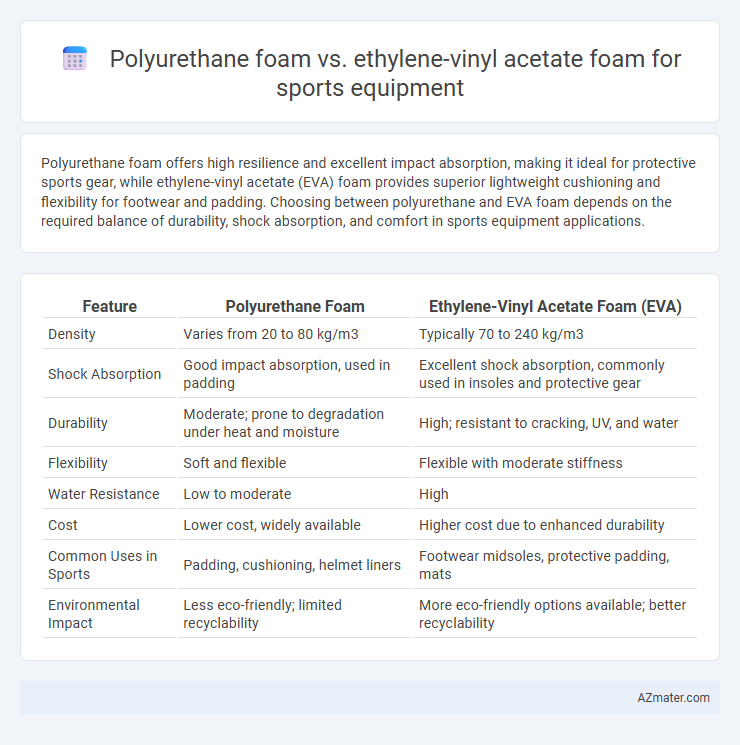Polyurethane foam offers high resilience and excellent impact absorption, making it ideal for protective sports gear, while ethylene-vinyl acetate (EVA) foam provides superior lightweight cushioning and flexibility for footwear and padding. Choosing between polyurethane and EVA foam depends on the required balance of durability, shock absorption, and comfort in sports equipment applications.
Table of Comparison
| Feature | Polyurethane Foam | Ethylene-Vinyl Acetate Foam (EVA) |
|---|---|---|
| Density | Varies from 20 to 80 kg/m3 | Typically 70 to 240 kg/m3 |
| Shock Absorption | Good impact absorption, used in padding | Excellent shock absorption, commonly used in insoles and protective gear |
| Durability | Moderate; prone to degradation under heat and moisture | High; resistant to cracking, UV, and water |
| Flexibility | Soft and flexible | Flexible with moderate stiffness |
| Water Resistance | Low to moderate | High |
| Cost | Lower cost, widely available | Higher cost due to enhanced durability |
| Common Uses in Sports | Padding, cushioning, helmet liners | Footwear midsoles, protective padding, mats |
| Environmental Impact | Less eco-friendly; limited recyclability | More eco-friendly options available; better recyclability |
Introduction to Foam Materials in Sports Equipment
Polyurethane foam offers high resilience and excellent shock absorption, making it ideal for protective sports gear such as helmets and padding. Ethylene-vinyl acetate (EVA) foam provides superior flexibility, lightweight cushioning, and durability, commonly used in sports footwear midsoles and insoles. Both foam materials enhance athlete comfort and performance by providing targeted impact protection and energy return.
What is Polyurethane (PU) Foam?
Polyurethane (PU) foam is a versatile, lightweight material widely used in sports equipment for its excellent cushioning, shock absorption, and durability properties. It is created through the reaction of polyols and diisocyanates, resulting in a cellular structure that provides high resilience and comfort. PU foam outperforms Ethylene-vinyl acetate (EVA) foam in terms of density and long-term wear resistance, making it ideal for protective gear and padding in athletic applications.
What is Ethylene-Vinyl Acetate (EVA) Foam?
Ethylene-vinyl acetate (EVA) foam is a lightweight, flexible, and durable material widely used in sports equipment for its excellent shock absorption and cushioning properties. This polymer resin combines ethylene and vinyl acetate to create a closed-cell foam that resists UV radiation, water, and stress cracking, making it ideal for protective gear, insoles, and padding. Compared to polyurethane foam, EVA offers superior flexibility and resilience, enhancing comfort and injury prevention in athletic applications.
Cushioning and Shock Absorption Comparison
Polyurethane foam offers superior cushioning and higher shock absorption due to its open-cell structure, making it ideal for high-impact sports equipment like helmets and protective pads. Ethylene-vinyl acetate (EVA) foam provides a lighter, more flexible solution with moderate shock absorption, commonly used in running shoe midsoles and insoles for enhanced comfort and energy return. The denser composition of polyurethane foam absorbs impact forces more effectively, while EVA foam balances cushioning with durability and resilience under repeated stress.
Durability and Longevity in Sports Applications
Polyurethane foam offers superior durability and resistance to wear, making it ideal for high-impact sports equipment such as helmets and protective pads, where prolonged use and consistent performance are critical. Ethylene-vinyl acetate (EVA) foam provides excellent shock absorption and flexibility but tends to degrade faster under continuous stress and exposure to environmental factors, limiting its longevity in demanding sports applications. Choosing polyurethane foam ensures enhanced lifespan and structural integrity, whereas EVA foam suits lighter, lower-impact gear requiring less durability.
Flexibility and Impact Response Characteristics
Polyurethane foam offers superior impact absorption with excellent energy dispersion, making it ideal for protective sports gear requiring high shock resistance. Ethylene-vinyl acetate (EVA) foam provides enhanced flexibility and resilience, allowing for better movement and comfort in equipment like insoles and padding. EVA's lightweight nature combined with its durable elastic properties ensures prolonged comfort without compromising impact resistance.
Weight and Comfort Considerations
Polyurethane foam offers higher density and superior impact absorption, making it ideal for protective sports gear, but it tends to be heavier and less breathable compared to ethylene-vinyl acetate (EVA) foam. EVA foam is lightweight and flexible, enhancing comfort and mobility by providing better cushioning and ventilation in sports equipment like insoles and padding. When choosing between the two, polyurethane foam prioritizes durability and impact protection while EVA foam focuses on reduced weight and enhanced wearer comfort.
Water and Sweat Resistance Performance
Polyurethane foam offers moderate water resistance but tends to absorb sweat over time, leading to reduced durability in sports equipment. Ethylene-vinyl acetate (EVA) foam excels in water and sweat resistance due to its closed-cell structure, making it ideal for moisture-prone environments. Athletes often prefer EVA foam for sports padding and insoles because it maintains cushioning properties and prevents odor buildup during intense physical activity.
Environmental Impact and Sustainability
Polyurethane foam used in sports equipment often involves petrochemical derivatives that contribute to higher carbon emissions and are less biodegradable, raising concerns over environmental sustainability. Ethylene-vinyl acetate (EVA) foam is generally more environmentally friendly due to its lower density, longer durability, and potential for partial recyclability, reducing waste generation in sports gear manufacturing. Choosing EVA foam supports greener practices by minimizing ecological footprints and promoting sustainable materials within athletic product design.
Choosing the Right Foam for Your Sports Gear
Polyurethane foam offers excellent impact absorption and durability for sports equipment requiring high shock resistance, while ethylene-vinyl acetate (EVA) foam provides superior flexibility and lightweight cushioning ideal for footwear and protective gear. Selecting the right foam depends on the specific application, balancing factors like compressive strength, resilience, and moisture resistance to enhance performance and comfort. Sports gear benefiting from enhanced energy return and longevity often favors EVA foam, whereas equipment demanding robust support and abrasion resistance tends to utilize polyurethane foam.

Infographic: Polyurethane foam vs Ethylene-vinyl acetate foam for Sports equipment
 azmater.com
azmater.com